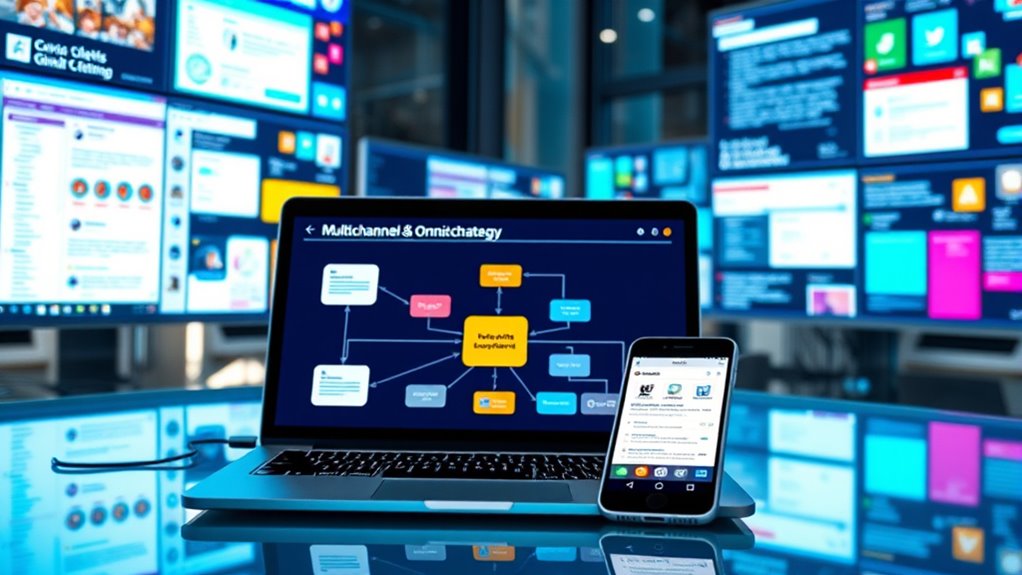In multichannel platforms, email acts as a standalone tool used alongside other channels, with performance tracked separately. Omnichannel platforms, however, seamlessly integrate email with other channels, offering real-time data synchronization for consistent messaging and a unified customer experience. This integration helps you build stronger relationships through personalized, connected interactions. Want to understand how these strategies impact customer engagement? Keep exploring to discover how choosing the right approach can transform your marketing efforts.
Key Takeaways
- Multichannel platforms treat email as a standalone communication channel, separate from others.
- Omnichannel platforms integrate email seamlessly with other channels for consistent messaging.
- Real-time data syncing in omnichannel platforms enables personalized email content based on customer interactions.
- Multichannel email campaigns require manual performance monitoring and separate strategy adjustments.
- Omnichannel email management ensures unified conversations, brand consistency, and improved customer experience.
Defining Multichannel and Omnichannel Strategies

While both multichannel and omnichannel strategies aim to reach customers across multiple platforms, they differ considerably in execution and focus. Multichannel emphasizes channel differentiation, meaning you manage each platform separately, often with distinct messaging and goals. Your focus is on providing options for customers to engage through various channels, but these channels may operate in silos. Omnichannel, on the other hand, centers on strategy alignment, ensuring a seamless customer experience across all touchpoints. You coordinate your channels to create a unified journey, where each platform complements the others. The key difference lies in integration: multichannel offers diverse options, while omnichannel harmonizes those options into a cohesive, customer-centric approach. Additionally, effective customer engagement depends on your ability to integrate channels seamlessly rather than merely offering multiple options. Understanding this distinction helps you choose the right strategy for your business goals.
The Role of Email in Multichannel Approaches

In multichannel strategies, email functions as a pivotal communication tool that operates independently alongside other platforms. You can leverage email analytics to measure open rates, click-throughs, and conversions, helping you understand how your messages perform. Campaign segmentation allows you to tailor content to specific audience groups, increasing relevance and engagement. Since each channel works separately, you need to coordinate your messaging carefully to maintain consistency across platforms. Email’s flexibility makes it ideal for targeted outreach, nurturing leads, or reinforcing brand messages. However, because it’s not seamlessly integrated, you must monitor performance individually and adjust strategies accordingly. Additionally, passive voice detection tools can help identify and improve sentence clarity, ensuring your messaging remains direct and impactful. Ultimately, email remains an essential component in a multichannel approach, providing valuable insights and personalized communication opportunities.
How Omnichannel Platforms Integrate Email Seamlessly

Omnichannel platforms connect your email with other channels through unified messaging streams, ensuring your messages stay consistent across touchpoints. They also sync data in real time, allowing you to personalize communications instantly. As a result, your brand experience remains seamless and cohesive for every customer interaction. Additionally, understanding family dynamics can enhance the authenticity of celebrity endorsements by providing deeper insight into their backgrounds.
Unified Messaging Streams
To deliver a truly seamless customer experience, omnichannel platforms integrate email into unified messaging streams that allow different communication channels to work together effortlessly. This integration ensures cross channel consistency, so your customers receive the same messaging, tone, and branding regardless of the platform they use. Message synchronization plays a crucial role here, keeping conversations connected and up-to-date across all channels. When a customer replies to an email, their response is instantly reflected in other messaging streams, eliminating confusion and fragmented communication. By unifying these streams, your team can manage all interactions from a single interface, providing faster responses and more personalized service. This seamless flow enhances customer satisfaction and builds trust, making your communication more effective and aligned across every touchpoint. Incorporating projector technology concepts can help visualize and optimize multi-channel workflows for better customer interactions.
Real-Time Data Syncing
Real-time data syncing is the backbone of seamless email integration within omnichannel platforms, ensuring that every interaction is immediately reflected across all channels. This process facilitates data synchronization, allowing your systems to stay current with customer actions and preferences. When a customer opens an email or clicks a link, that data instantly updates across platforms, enabling personalized follow-ups and targeted messaging. Platform interoperability plays a pivotal role here, as it guarantees different systems work together smoothly without delays. By maintaining real-time data sync, your omnichannel platform provides a unified view of customer interactions, empowering you to deliver more relevant content and improve engagement. Implementing juice tips and tricks can help optimize data management and enhance overall system efficiency. This seamless integration ultimately fosters a more cohesive customer experience, driving loyalty and increasing conversions.
Consistent Brand Experience
Seamless integration of email within omnichannel platforms guarantees your brand delivers a consistent experience across all touchpoints. When your email campaigns align with your broader marketing efforts, it strengthens brand consistency and reinforces your visual identity. Customers shouldn’t feel like they’re interacting with different brands on various channels; instead, they should experience a unified message, look, and feel. Omnichannel platforms ensure that your email content matches your website, social media, and in-store branding. This cohesion builds trust and recognition, encouraging customer loyalty. By maintaining visual identity across channels, you create a familiar environment that resonates with your audience, making every interaction feel intentional and connected. Additionally, energetic alignment ensures that your messaging resonates on a deeper level, enhancing overall engagement. Ultimately, this consistency elevates your brand’s reputation and fosters long-term engagement.
Customer Experience: Comparing Multichannel and Omnichannel

While both multichannel and omnichannel platforms aim to enhance customer experience, they approach it differently. Multichannel strategies deliver messages across various channels, but interactions often feel disconnected, which can hinder customer loyalty. Omnichannel platforms, on the other hand, unify these channels, creating a seamless experience. This consistency encourages you to stay engaged and trust your brand more. Data segmentation plays a vital role here, allowing you to personalize interactions based on customer preferences and behaviors. With omnichannel, your marketing becomes more relevant, fostering stronger relationships. Additionally, understanding relationship dynamics can help tailor communication strategies to build deeper customer trust. Ultimately, the omnichannel approach prioritizes a smooth, integrated journey that boosts customer satisfaction and loyalty, whereas multichannel may leave gaps that fragment your experience.
Benefits of a Unified Customer View With Omnichannel

Having a unified customer view with omnichannel enables you to understand your customers more deeply by consolidating all their interactions into a single, thorough profile. This exhaustive view ensures your customer data is accurate and up-to-date, allowing you to identify preferences and behaviors across channels. With detailed insights, you can personalize marketing automation efforts, delivering relevant messages at the right moments. A unified perspective reduces data silos and streamlines your marketing strategies, leading to more consistent and engaging customer experiences. It also helps you spot trends and opportunities faster, enabling proactive engagement. To strengthen customer relationships, maintaining a positive energy and trusting the process can significantly enhance your marketing effectiveness. Ultimately, this holistic approach boosts customer loyalty and improves your overall marketing effectiveness by providing a clear, real-time picture of customer journeys.
Challenges in Implementing Multichannel and Omnichannel Systems

Implementing multichannel and omnichannel systems presents several significant challenges, primarily because integrating diverse platforms requires careful coordination and technical expertise. One major obstacle is overcoming integration hurdles, which can involve complex data synchronization and ensuring consistent messaging across channels. These systems often operate on different technologies, making seamless communication difficult. Additionally, staff training becomes essential; your team must learn to manage multiple platforms efficiently and adapt to new workflows. Without proper training, errors increase, and the benefits of a unified customer experience diminish. Effective content management is crucial to maintain consistency and accuracy across channels. Balancing technical integration with effective staff onboarding demands time and resources. Addressing these challenges early on is vital to guarantee a smooth transition and maximize the value of your multichannel or omnichannel strategy.
Choosing the Right Platform for Your Business Needs

How do you choose the right platform that aligns with your business goals and customer expectations? Start by evaluating how well the platform supports customer segmentation, allowing you to target specific groups with tailored messages. Look for features that enable campaign automation, so you can streamline your marketing efforts and guarantee timely delivery across channels. Consider whether the platform offers seamless integration with your existing systems and whether it can scale as your business grows. A good fit should simplify managing multiple touchpoints while providing insights to refine your strategy. Additionally, assessing the platform’s content management capabilities can help ensure your messaging remains consistent and relevant across all channels. Ultimately, your choice depends on balancing these capabilities with your budget and operational needs, ensuring you can deliver personalized, consistent experiences that foster customer loyalty.
Future Trends in Customer Engagement and Communication

AI-driven personalization will become more sophisticated, allowing you to tailor experiences uniquely for each customer. Integrated communication channels will enable seamless interactions across platforms, making engagement more efficient. Together, these trends will transform how you connect with your audience, creating more meaningful and responsive conversations.
AI-Driven Personalization Rise
As technology advances, personalized customer experiences are becoming more sophisticated and seamless. AI personalization leverages data-driven insights to tailor interactions in real-time, making messaging more relevant and engaging. By analyzing customer behaviors, preferences, and purchase history, AI tools can predict what each person wants and deliver customized content instantly. This shift allows you to connect more deeply with your audience, increasing loyalty and conversion rates. The rise of AI-driven personalization means you no longer rely on generic campaigns but instead create highly targeted experiences that adapt as customer needs evolve. As a result, your communication becomes more effective, efficient, and aligned with individual expectations, giving your brand a competitive edge in an increasingly crowded marketplace.
Integrated Communication Channels
Integrated communication channels are shaping the future of customer engagement by seamlessly connecting multiple touchpoints into a unified experience. This approach helps you combat channel fragmentation, ensuring customers receive consistent messages regardless of how they interact with your brand. When channels work together smoothly, your messages stay aligned across email, social media, chat, and other platforms, enhancing message consistency. This integration prevents disjointed customer experiences that can arise from isolated channels. By creating a cohesive communication strategy, you foster trust and loyalty, making every interaction feel personalized and relevant. As technology advances, integrated channels will become essential for delivering a seamless, consistent, and engaging customer journey across all touchpoints.
Frequently Asked Questions
How Does Email Personalization Differ Between Multichannel and Omnichannel Platforms?
You’ll notice email personalization varies between multichannel and omnichannel platforms. In multichannel setups, you mainly rely on customer segmentation to tailor content across channels individually. In omnichannel platforms, dynamic content plays a key role, allowing you to craft seamless, personalized experiences by integrating customer data across all touchpoints. This approach guarantees your emails reflect real-time preferences, making each message more relevant and engaging for the customer.
What Are the Cost Implications of Adopting Omnichannel Email Strategies?
When considering adopting omnichannel email strategies, you need to conduct a thorough cost analysis to understand the investment involved. While initial setup may require higher budget planning, you’ll benefit from streamlined campaigns and better customer engagement. Over time, these strategies can reduce costs by improving efficiency and ROI. Keep in mind, integrating multiple channels often demands more resources upfront, but the long-term gains justify the expenditure.
How Do Privacy Regulations Impact Email Integration in These Platforms?
Think of privacy regulations as a strict traffic cop guiding your email integration. You must follow data privacy rules and guarantee regulatory compliance to keep your platform running smoothly. These regulations impact how you collect, store, and use data, making sure customer info stays protected. Ignoring them risks fines and damage. So, you need to adapt your strategies to stay compliant while maintaining seamless email integration across your channels.
Can Small Businesses Effectively Implement Omnichannel Email Solutions?
You can definitely implement omnichannel email solutions as a small business. Focus on customer segmentation to tailor your messages and use content automation to save time and guarantee consistent communication. While it might seem complex, starting with simple tools and gradually expanding helps. You’ll build stronger relationships, improve engagement, and stay competitive. Just remember to stay compliant with privacy regulations, which are essential for maintaining customer trust.
What Metrics Best Measure Email Performance Within Multichannel Versus Omnichannel Systems?
You might think tracking email performance is straightforward, but A/B testing and engagement metrics reveal deeper insights. In multichannel systems, focus on open rates, click-through rates, and conversions to gauge effectiveness. Omnichannel setups require a broader view, combining those metrics with cross-channel engagement and customer journey data. This all-encompassing approach helps you optimize campaigns and understand how your emails influence overall customer behavior across platforms.
Conclusion
Ultimately, choosing between multichannel and omnichannel platforms is like picking a path in a bustling marketplace—you want clarity amidst the noise. By understanding how email seamlessly fits into each approach, you can craft a customer experience that feels personal and unified. Embrace the future of engagement with confidence, knowing that the right platform transforms every interaction into a memorable journey—where your customers are the stars of the show, shining brighter with every connection you make.
Natali – Editor in Chief (Strategy and Mastery, AI Expert) Natali, our Editor in Chief, is the driving force behind our content’s strategic direction. With a keen eye for detail and a deep understanding of market trends, Natali ensures that our content is top-notch and strategically aligned with our client’s goals. Her expertise in AI helps to seamlessly integrate advanced technology into our marketing strategies, pushing the boundaries of conventional marketing.










